
The Magical, Mythical Elves and Dwarves of Norse Legend
Today if one thinks of either elves or dwarves, the first thing to come to mind is likely to be the works of J.R.R Tolkien. Thanks to him, fantasy fiction goes hand in hand with elves and dwarves. Yet what many people do not realize is that he took his inspiration for them from Norse mythology. Both elves and dwarves played important roles in Norse mythology. Several Norse myths feature dwarves crafting precious objects, while Old Norse poems feature elves accompanying the gods. Here is everything you need to know about the elves and dwarves of Norse myth.
Origins of Dwarves in Norse Mythology
In fantasy fiction, dwarves are predominantly associated with craftsmanship and smithing, as well as dwelling deep beneath the earth under mountains. Appearance-wise, they are usually depicted as being short and unattractive.
This matches how they are portrayed in Norse mythology. While the old myths do not go into much detail as to their appearance, they are described as “dvergr of voxt” (short like a dwarf). The dvergar, or dwarves, of Norse mythology do have one ability not shared with their modern counterparts however: the ability to shapeshift.
The origins of the dwarves are explained in the Norse creation poem Völuspá, which is the first poem of the Poetic Edda. Before the gods, there was a giant called Ymir, from whom the gods created the Earth. In the poem’s ninth stanza, it states the gods had to decide who would lead the dwarves "out of Brimir’s blood and the legs of Blain". It is believed that Brimir and Blain are two other names for Ymir.
- The Weird, Wonderful and Wicked Beings in Scandinavian Folklore
- The Diverse Nature of Elves in Norse Myth: Beings of Light or Darkness?
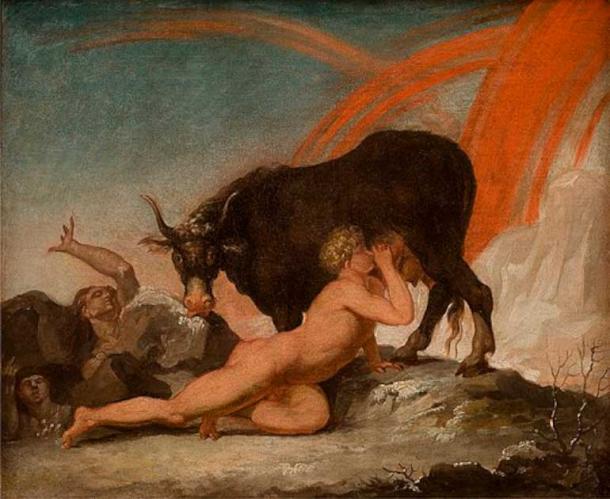
The giant Ymir predated the elves and dwarves in the Poetic Edda. Painting of Ymir’s birth, circa 1777. Dwarves emerged from Ymir like maggots. (Public Domain)
In the next stanza, two potential candidates for the leader of the dwarves are mentioned, Motsognir and Durin. Stanzas 9-16 act as a directory of dwarf names. Tolkien actually used the names that appear between stanzas 9 and 16 as inspiration. Gandalf comes from the Norse Gandalfr which means magic elf. He also referred to the dwarves of his books as Durin’s folk, a clear reference to the Durin of stanza 9.
Other important elves include Norþri, Suþri, Austri, and Vestri, who represent the points of the compass and are responsible for holding up the sky. There is also Lofar, who leads the dwarves from the mountains to find a new home, and Dvalin who, in the Hávamál, gives the rest of the dwarves magic runes that grant them their craftsmanship abilities.
The Prose Edda describes how the dwarves first appeared from Ymir’s flesh like maggots but were granted sentience by the gods. It explains that they can live in soils or rocks. This is backed up in another story, Sörla þáttr. This tells how the goddess Freyja slept with some dwarves to receive a splendid collar. In this story, it is stated that the dwarves resided in rocks and caves.
- Icelanders Believed in Elves, But it is Probably Not What You Think
- Revealing the True Nature of Elves: Dangerous Beauties and Diabolical Fiends
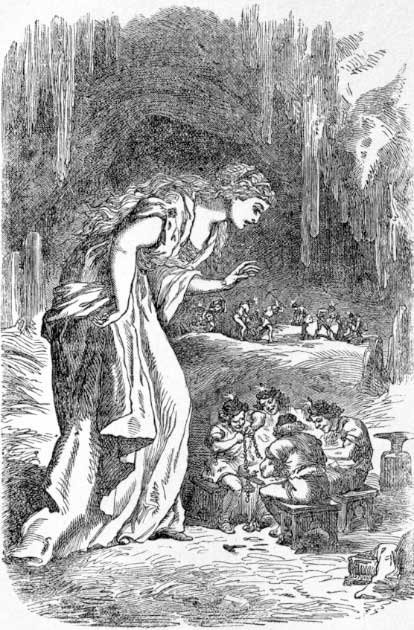
Freyja in the dwarfs' cave, book illustration from 1891 (Public Domain)
Not everything is clear-cut, however. The Prose Edda’s author, Snorri, also makes references to light-elves and dark elves. The difference between the two is that the light elves live in Alfheim, while the dark-elves live underground. This has led some scholars to conclude that dwarves and dark-elves are either the same or closely related.
Dwarves are usually depicted as being all male, but there is evidence that some were female. The Fáfnismál section of the Poetic Edda tells the story of how the Norse hero Sigurd killed a dragon. Before it died, the dragon told Sigurd that some of the Norn (female Norse deities who could predict the future and decide men’s fates) were related to Dvlain, one of the primary dwarves.
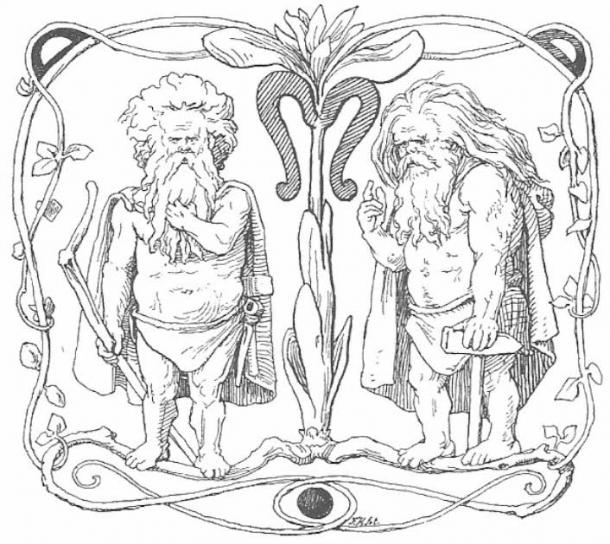
Two dwarves as depicted in a 19th-century edition of the Poetic Edda poem Völuspá (1895) by Lorenz Frølich. (Public Domain)
Dwarven Craftsmanship
The primary role of the dwarves in Norse mythology is to craft unusual or magical objects for the gods. A prime example of this is the tale of how Thor got his hammer in the Skáldskaparmál of the Poetic Edda.
The story starts with the trickster god Loki cutting the hair of Thor's wife, Sif, leaving her bald. Thor, as he was prone to do, reacted by forcing Loki to go to the dark elves and making him ask them to craft her new hair made from gold. These dark elves, known as the sons of Ivaldi, were the ones responsible for smithing Odin’s mighty spear, Gungnir, as well as Freyr’s ship, Skidbladnir.
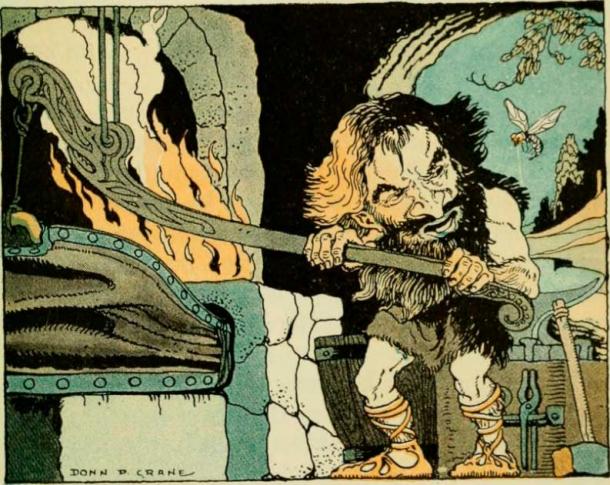
1922 illustration of the sons of Ivaldi crafting gifts for the gods (Public Domain)
The dwarves crafted Sif her new hair and she was delighted, but Loki wasn’t done. He made a bet with a dwarf called Brokk that Brokk and his brother Eitri couldn’t make three objects better than the ones above. If they could, Loki would give them his head.
Of course, being Loki, he attempted to cheat. Loki transformed into a fly and did his best to distract the two dwarf craftsmen. He landed on Brokk’s eyelid and bit it, causing him to make a mistake as he added the finishing touches to Mjolnir, Thor’s hammer. This resulted in Thor’s hammer being much shorter than a typical Norse war hammer.
As well as Mjolnir, the two brothers crafted the great ring Draupnir, which produced nine more rings every ninth night, and Gullinbortsi, a magic boar that could run faster than any horse. The gods were delighted with these gifts and deemed the two dwarves the victors of the bet.
Brokk then asked Thor to capture Loki so that they might take his head as a reward. Loki, however, proved himself a trickster once more by stating he had bet his head, not his neck. The dwarves got the last laugh; Brokk’s other brother, Alr, sealed Loki’s lips shut.

"The third gift — an enormous hammer" by Elmer Boyd Smith. The dwarves Sons of Ivaldi forge the hammer Mjolnir for the god Thor while Loki watches on. On the table before them sits their other creations: the multiplying ring Draupnir, the boar Gullinbursti, the ship Skíðblaðnir, the spear Gungnir, and golden hair for the goddess Sif. (Public Domain)
Elves in Norse Mythology
Compared to the dwarves of Norse mythology, we know comparatively little about the elves. They appeared in plenty of myths and throughout the poems of the Poetic Edda, but the literature devoted very little space to describing them.
We know that the elves were divided into two separate groups: the light elves, and dark elves, who are probably also the dwarves. The light elves, who live in Alfheim, are usually depicted as being close to the gods and divine in nature. In particular, they are described as being “more beautiful than the sun”.
Elves were most closely associated with the Aesir god Freyr, who was said to rule over Alfheim. The elves were depicted as often accompanying the various gods, joining them in council and when they went to war. In the Lokasenna of the Poetic Edda, it was explained that the elves were so divine they often accompanied the gods as both drinking companions and lovers.
Some scholars have gone so far as to claim that the elves and the gods were the same. In the Vǫluspá of the Poetic Edda, it appears that the terms Aesir and elves are synonymous with one another, implying that the elves were indeed gods. Other scholars have put this down to a technical poetic device rather than proof. This is backed up by the fact that other poems make clear delineations between the elves and gods.
The elves weren’t just depicted as interacting with the gods; they had an ambivalent relationship with humanity. In the stories of Norse mythology, elves are often shown causing human illnesses but are then also commonly shown healing them, for the right price.
In Norse mythology, humans and elves were able to interbreed and produce hybrid offspring. Their children were said to have the appearance of a normal human but had the magical powers and intuition of an elf. Some poems also make references to humans being able to become elves after death.
Various Nordic sagas make references to burial grounds being haunted by elves, and there was considerable overlap between the worship of people’s ancestors and the worship of elves.
The worship of elves actually outlived the worship of the Nordic gods. Centuries after most of Europe had converted to Christianity, people were still worshiping elves, leading medieval law codes to ban the practice.
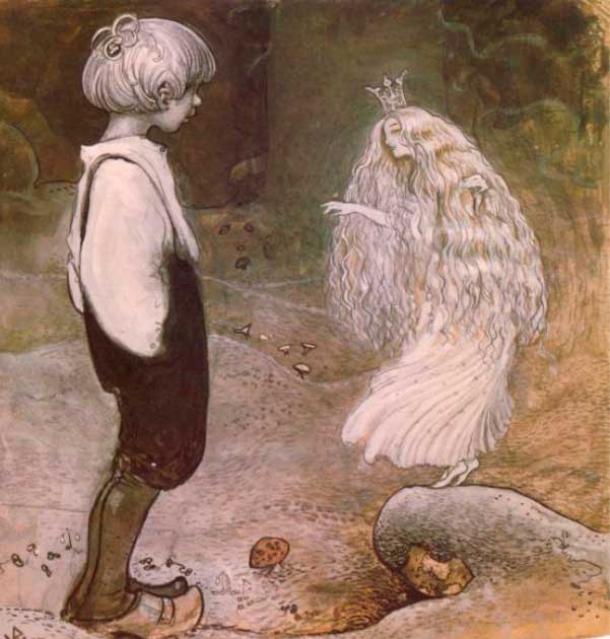
The Boy and the Elf, 1907 illustration by John Bauer (Public Domain)
Wayland the Smith
Of all the elves, the most famous was Wayland the Smith. The Völundarkviða of the Poetic Edda tells the story of how he was attacked by a human king, Nithuth, and how the elf got his revenge.
In the story, Wayland was the son of a king and a master craftsman. He and his brothers married some of the Valkyries (female Norse warrior spirits), but after several years the Valkyries flew away.
Wayland’s brothers set off to find their brides, leaving him at home. Wayland spent his time forging beautiful golden rings decorated with precious gems which he planned on gifting his wife upon her return. Nithuth heard about this and sent his men to capture the elf while he was home alone.
Wayland was brought to Nithuth’s castle, where he was stripped of his swords and one of the rings was given to Nithuth’s daughter. Unsurprisingly, Wayland reacted badly. Nithuth’s wife remarked how "his eyes are glowing like glistening snakes”, and he "gnashes his teeth” every time he saw the humans handling his sword and ring.
The humans began to fear the elf and cut his hamstrings before dumping him on an island. He was left there, forced to work as a slave for the human king. He spent his days crafting beautiful objects for the king, never resting.
Nithuth’s sons began visiting the island so that they could watch the elf work. During one of their visits, the elf killed them and hid their corpses beneath his bellows. He made silver cups from their skulls for their father, gems out of their eyes for the queen, and a brooch out of their teeth for their sister, Bothvid.
Later on, Bothvild broke her ring and asked Wayland to fix it. Wayland agreed and the two end up drinking together. Wayland managed to seduce the princess, making her his lover. He impregnated her before somehow managing to escape the island.
Sadly, today the poem is incomplete, so we are missing some details as to how Wayland escaped the island, but it is believed he may have done so by crafting an eagle costume with the help of one of his brothers. The story ends with the king summoning Wayland to explain what Wayland had done to Nithuth’s sons.
Wayland agreed to tell the king as long as he promised not to harm Bothvild or the child she was carrying. The king was desperate for revenge but agreed. The poem ends with Wayland confessing to killing the sons and flying off before the king could hurt him.
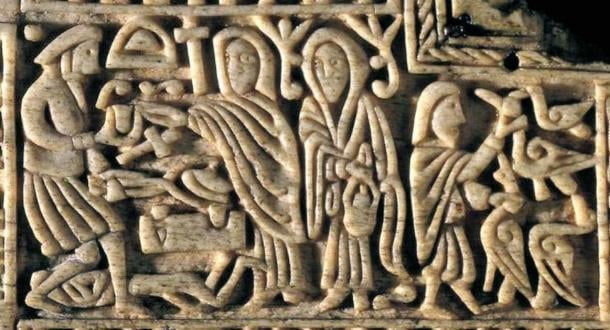
Close-up of the front panel of the Franks Casket, Auzon, France, 8th century AD. This part of the casket features an Anglo-Saxon depiction of the Wayland (Volund) legend. Wayland is depicted next to his forge and tools, with the decapitated body of one of King Niðhad’s sons before him. He is offering a goblet fashioned from the skull to a woman, probably the king’s daughter, Bodvild. The second female figure is either an attendant or Bodvild again. The male figure on the right side is either Wayland or one of his brothers. He is strangling geese to collect feathers for a flying machine. (Public Domain)
In the story of Wayland the Smith, we see a common motif that persists even today: Don’t anger an elf. In the beginning, Wayland is peaceful, but after being attacked by the humans, becomes aggressive and vindictive. The story is likely responsible for the old belief that if you crossed an elf, there would be dire consequences.
The medical term stroke comes from the old notion that if you annoyed an elf, they would smite you. It was also commonly thought that bad luck in general was the work of malevolent elves. Later Christians associated these old ideas of elves with demons and devils. This was in part responsible for the churches’ ban of elven worship; it was seen as devil worship.
Conclusion
In most modern works of fantasy, the lines between elves and dwarves are clear-cut. But the Northmen who first told stories about them weren’t as interested in making distinctions as we are today.
The elves and dwarves enjoyed an intermediary position somewhere above mortal men but below the gods. They were likely viewed as interchangeable, as seen by the confusion between the differences between dark-elves and dwarves and whether they were the same or not.
This confusion is made worse by the fact that our understanding of Norse mythology is incomplete. Many of the original texts and sources have been lost, and we are often left relying on later retellings of these early stories.
While they vary from their modern fantasy counterparts, the building blocks for Tolkien’s elves can be clearly found in the stories of Norse mythology. It is funny to think that Tolkien spent so much time differentiating the two when the Nordic storytellers seemed so uninterested in doing so.
Top Image: Elves and dwarves played crucial roles in Norse mythology. Dancing Fairies, painting by August Malmström, 1866. Source: Public Domain
By Robbie Mitchell
References
Manea, I. March 8, 2021. Elves & Dwarves in Norse Mythology. World History Encyclopedia. Available at: https://www.worldhistory.org/article/1695/elves--dwarves-in-norse-mythology/
Hildebrand, K. 2022. The Poetic Edda, Old Norse-English Diglot. Melbourne.
O'Donoghue, H. 2004. Old Norse-Icelandic Literature. Wiley-Blackwell.















